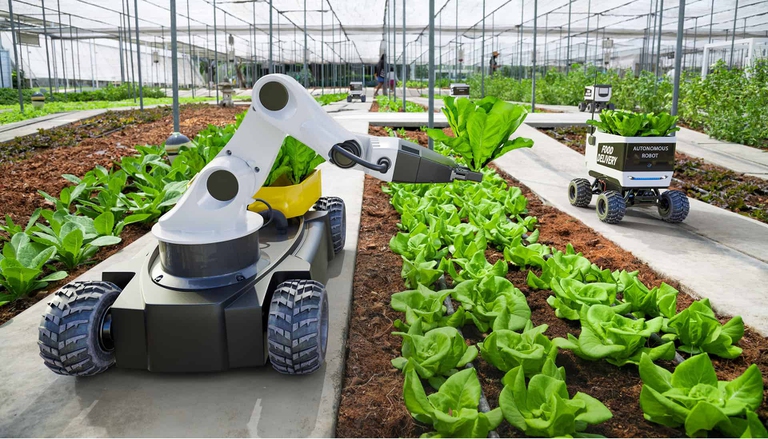https://www.lifegate.it/agricoltura-tecnologia-xfarm
- |
Drones, robots, sensors, big data.In times of climate change, these will be the tools of the new sustainable agriculture and regenerative?According to what emerges from the third edition of theAgri data green summit, organized on October 23 by Xfarm, it seems so.Extreme weather events are now an increasingly frequent reality, and agricultural companies must be able to manage the risks with sophisticated means.They are not enough insurance tools, which intervene after the damage and with compensation times that are often long, but they are useful analytical, predictive tools and new cultivation techniques.Technology can help and, paradoxically, encourage more natural cultivation methods with less use of chemicals.The integration between data collected by drones or through satellite maps and artificial intelligence can be used to estimate the risk of flooding, to predict the surrender of crops, to monitor the temperature or the degradation of the soil.
“2024 was a very difficult year for Italian agriculture – he begins Antonio Boschetti, director of Informatore Agrario, who spoke at the summit – for the climatic conditions that brought an excess of rain and real floods to the North.There have been delays and reductions in harvests for durum wheat, corn, olive trees, while the war in Ukraine led to a rally in utilities and commodities.The agricultural balance has been negative for several years and now the direct and indirect effects of climate changes they are normal.Software and technological tools such as DSS, decision support system, are one of the solutions, but awareness of them must increase in a sector that sees a very limited share of digital natives."

The real point of introducing technology into agriculture, however, is change of mentality from traditional parameters, which are proving insufficient, towards a data driven approach.This year 40 percent of corn was sown late, while the flowering of screw in Trentino is brought forward by 30 days in 30 years, making different cultivation techniques necessary to protect the bunches from high temperatures.Meanwhile, viticulture is increasingly moving north, such as in the United Kingdom and Poland.
“In Emilia-Romagna the precipitation of May 2023 they reached half the amount of rain that fell all year – he explains Paolo Tarolli, professor of agricultural hydraulics at the University of Padua –.Conversely, on the Po delta we detect principles of micro-desertification with a high salt content in the soil".Projections say that, by the end of the century, tropical climate zones could rise from 17 to 23 percent and arid zones from 25 to 35 percent of the total.
“These are new scenarios, with phenomena that need to be monitored – continues Tarolli – monitoring and artificial intelligence allow us to process big data.They have made it possible to detect, for example through high resolution maps, that where there is an abundance of organic substance the crops have suffered less, therefore their presence should be favored as a form of protection against the risk of drought".There are many solutions, and in some cases they involve the rediscovery of traditions such as, in viticulture, i micro-invasions in the hills, reservoirs that favor the creation of wet areas, retaining rainwater, so as to make sloping agricultural systems more resilient".
The issue of financing remains central in agriculture
The problems are not limited to the vine, but involve numerous supply chains, such as that of rice, corn and pastures.“In recent years hundreds of small stables have closed – he confirms Fabio Capitanio, associate of veterinary medicine at the Federico II University of Naples – with a loss not only economically, but of identity and biodiversity of the national territory.The role of institutions is fundamental in helping to manage risk by sharing technological innovation and the resulting knowledge."

Thought also goes to the budget of the new one Pac (Common Agricultural Policy) shortly under discussion, from which financial levers and facilitations in access to credit are expected.“Investments in technology are a great opportunity – he comments Annamaria Barile of Confagricoltura – but bordering on unrealistic in a world of small businesses:the acceleration given by the tax credit has demonstrated how central the problem of financing and the possibility of planning are in the sector".
“Our consortium – he assures Luca Lovatti R&D manager of Melinda – takes care of the risk management expenses, so as to make innovative systems of adaptability to climate change economically sustainable for participating companies.The translation of big data calculations, however, must be made accessible with very simple tools for farmers, because cultural change in agriculture is very difficult."
On the other hand, a model based on big data can only see transparency And sharing as cornerstones of a new model of agriculture:is the challenge of Andriani, which markets legume pasta under the Felicia brand and has almost completed the digitalisation of the supply chain by mapping 5,000 hectares, which launched the idea of a supply chain collaboration between cereal growers right from the summit.
Tea among the solutions being tested
In the meantime, research is moving forward and some answers are coming from Assisted evolution techniques (Tea), i.e. without insertion of external genetic material.“We have started testing RIS8imo, a new type of rice that better resists plant diseases, in particular brusone, which today requires the use of fungicides - explains Vittoria Francesca Brambilla of the University of Milan -, while in Veneto we are planting a vine that resists downy mildew.These are crops that until recently were considered GMOs and therefore prohibited, but which allow the creation of varieties more resistant to diseases and at stressful environmental conditions without use of pesticides, agrochemicals or greater use of water".
Unfortunately the first field was the subject of a vandalism episode, but some seedlings survived, and the experimentation can continue.Ignorance, however, still seems to be the most difficult weed to eradicate.
